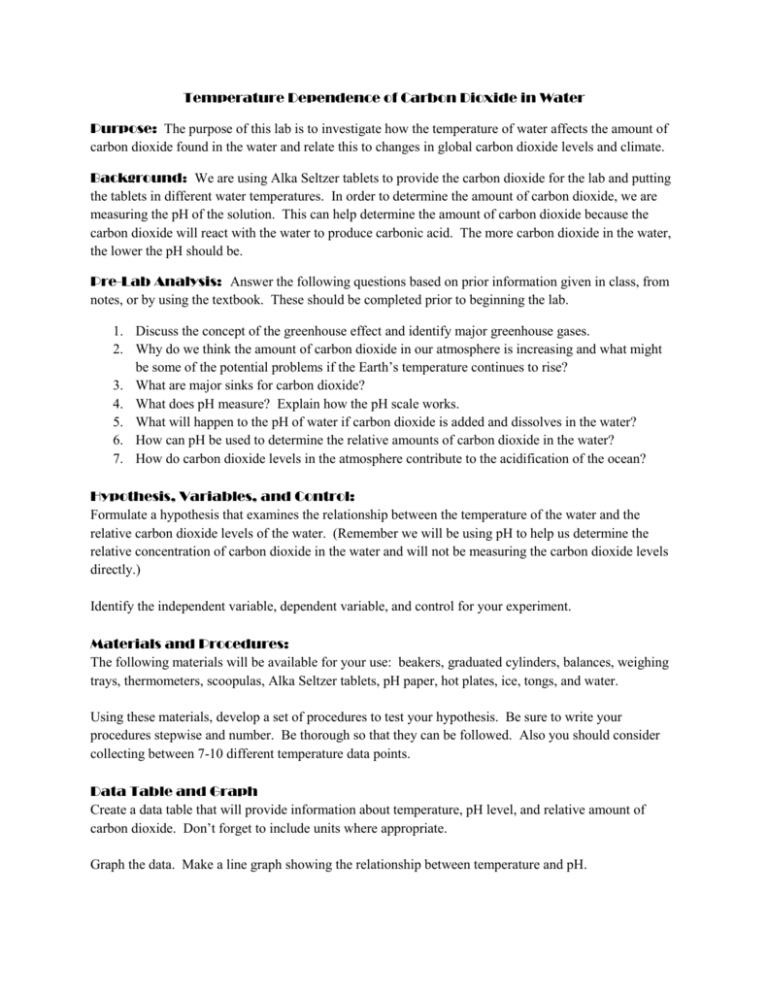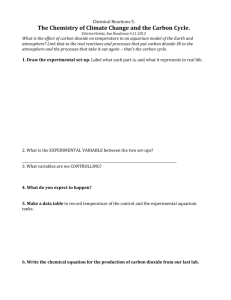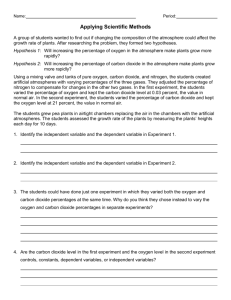Temperature Dependence of Carbon Dioxide in Water Lab
advertisement

Temperature Dependence of Carbon Dioxide in Water Purpose: The purpose of this lab is to investigate how the temperature of water affects the amount of carbon dioxide found in the water and relate this to changes in global carbon dioxide levels and climate. Background: We are using Alka Seltzer tablets to provide the carbon dioxide for the lab and putting the tablets in different water temperatures. In order to determine the amount of carbon dioxide, we are measuring the pH of the solution. This can help determine the amount of carbon dioxide because the carbon dioxide will react with the water to produce carbonic acid. The more carbon dioxide in the water, the lower the pH should be. Pre-Lab Analysis: Answer the following questions based on prior information given in class, from notes, or by using the textbook. These should be completed prior to beginning the lab. 1. Discuss the concept of the greenhouse effect and identify major greenhouse gases. 2. Why do we think the amount of carbon dioxide in our atmosphere is increasing and what might be some of the potential problems if the Earth’s temperature continues to rise? 3. What are major sinks for carbon dioxide? 4. What does pH measure? Explain how the pH scale works. 5. What will happen to the pH of water if carbon dioxide is added and dissolves in the water? 6. How can pH be used to determine the relative amounts of carbon dioxide in the water? 7. How do carbon dioxide levels in the atmosphere contribute to the acidification of the ocean? Hypothesis, Variables, and Control: Formulate a hypothesis that examines the relationship between the temperature of the water and the relative carbon dioxide levels of the water. (Remember we will be using pH to help us determine the relative concentration of carbon dioxide in the water and will not be measuring the carbon dioxide levels directly.) Identify the independent variable, dependent variable, and control for your experiment. Materials and Procedures: The following materials will be available for your use: beakers, graduated cylinders, balances, weighing trays, thermometers, scoopulas, Alka Seltzer tablets, pH paper, hot plates, ice, tongs, and water. Using these materials, develop a set of procedures to test your hypothesis. Be sure to write your procedures stepwise and number. Be thorough so that they can be followed. Also you should consider collecting between 7-10 different temperature data points. Data Table and Graph Create a data table that will provide information about temperature, pH level, and relative amount of carbon dioxide. Don’t forget to include units where appropriate. Graph the data. Make a line graph showing the relationship between temperature and pH. Post-Lab Analysis: After completing the lab, analyze and discuss your results in complete sentences. 1) Discuss the relationship between pH and temperature. 2) Discuss the relationship between pH and carbon dioxide levels. 3) From this, what can you conclude about the connection between the temperature of water and the solubility of carbon dioxide? 4) In class we discussed that as the levels of carbon dioxide in the oceans is increasing, the pH at the poles is changing faster than it is at the equator. Thinking in terms of temperature, why do you think this is happening? 5) Discuss a possible effect of increased water temperature on ocean acidification. 6) On the basis of what you learned, if the earth’s climate warms because of additional carbon dioxide in the atmosphere, what will happen to the ocean’s ability to absorb carbon dioxide? Will it stay the same, increase, or decrease? Why? 7) If the amount of carbon dioxide in the atmosphere determines the amount of heating of the earth due to the Greenhouse effect, how do you think the warming of the ocean water will affect the global climate? 8) Discuss any possible errors in your lab and how they might have affected the results. What could you do to improve the experiment for the future?







